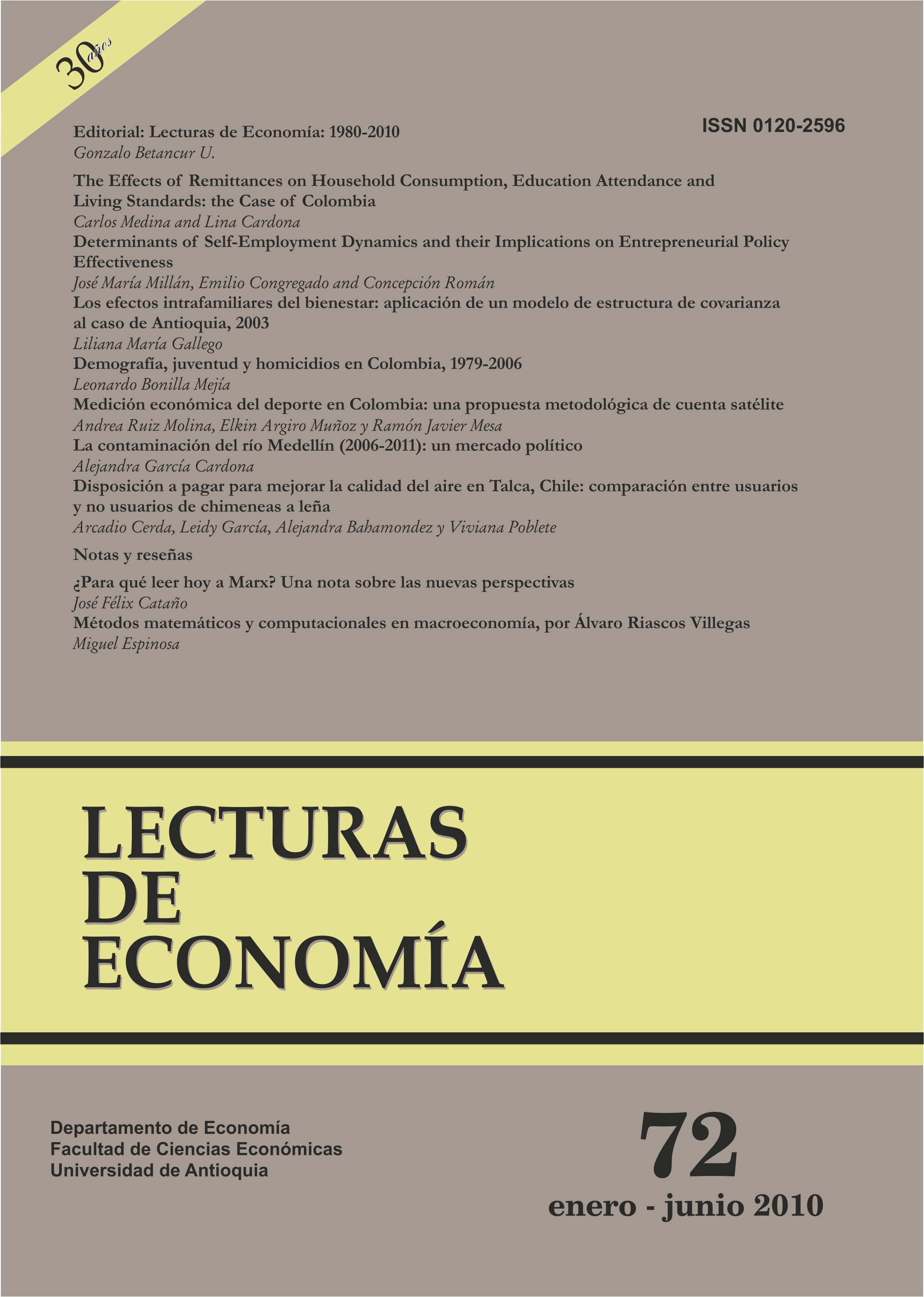Comparison of Willingness To Pay (WTP) for an Improvement in Air Quality between Users and Nonusers of Firewood in the City of Talca (Chile)
DOI:
https://doi.org/10.17533/udea.le.n72a6521Keywords:
willingness to pay, air pollution costs, contingent valuationAbstract
The objective of this study is to analyze the difference in the willingness to pay (WTP) for an improvement in air quality between users and nonusers of firewood at the locality of Florida in Talca (Chile). This analysis applied a contingent valuation approach, with a doubled-bound dichotomous choice format. By creating a certifying institution of dry firewood and assuming a linear and a logistic distribution function, this method calculates the WTP of an improvement in local air quality. The obtained value suggests the feasibility of financing the certifying institution’s operation costs via an environmental municipal fee. Additionally, the findings imply that Florida’s inhabitants using firewood are willing to pay a smaller amount than those who are not.
Downloads
References
Arrow, Kenneth, et al. (1993). Report of the NOAA Panel on contingent valuation. NOAA, Washington, DC, Reporte.
Azqueta, Diego (1994). Valoración económica de la calidad ambiental”, McGraw-Hill, España.
Boyle, Kevin y Bishop, Richard (1988). “Welfare Measurements using contingent valuation: a comparison techniques, American Journal of Agricultural Economics, Vol. 70, No. 1, pp. 20-28.
Campos, Nélyda; Vásquez, Felipe y Cerda, Arcadio (2001). “Estimaciones paramétricas, semiparamétricas y no paramétricas en valoración contingente: aplicación a un problema de calidad del aire”, Revista Economía y Administración, año XXXVIII, No. 57.
Cerda, Arcadio; García, Leidy; Fuentes, Pía y Benavides, Paula (2009). Contaminación del aire en la Florida (Talca, Chile): costos económicos en la salud, Documento de Trabajo. Facultad de Ciencias Empresariales, Universidad de Talca, Chile.
Cerda, Arcadio; Rojas, José, García, Leidy (2007). “Disposición a pagar por un mejoramiento en la calidad ambiental en el Gran Santiago”, Lecturas de Economía, Vol. 67, pp. 143-160.
Cerda, Arcadio y Vásquez, Felipe (2000). “Differences between parametric and non-parametric estimation of welfare measures: An application to the Rio Claro, Talca, Chile”, Panorama Socioeconómico, año 23, No. 31, pp. 22-31.
Cerda, Arcadio; Riofrío, Mercedes y Vial, Fernando (1997). “Valoración Contingente para la Creación de la Reserva “Shangri-La”, en la VIII Región Chile”, Lecturas de Economía, No. 47, pp. 47-65.
Cerda, Arcadio; Orrego, Sergio y Vásquez, Felipe (1997). “The Economic Valuation of the recreational benefits of Dichato Beach (Tomé-Chile)”, Lecturas de Economía, No. 46, pp. 73-94.
Cerda, Arcadio y Fuentes, José (1994). “Valoración Contingente: Una aplicación para una zona lacustre en Concepción”, Revista Economía y Administración, año XXXI, pp. 73-82.
Cooper, Joseph y Hellerstein, Daniel (1994). “CVM Software”, USDA/ ERS/Resources and Technology Division, Washington DC, 20005-4788.
Cooper, Joseph (1993). “Optimal Bid Selection for Dichotomous Choice Contingent Valuation Surveys”, Journal of Environmental Economics and Management, No. 24, pp. 25-40.
Cooper, Joseph y Loomis, John (1992). “Sensitivity of Willingness to Pay Estimates to Bid Design in Dichotomous Choice Contingent Valuation Models”, Land Economics, Vol. 68, No. 2, pp. 211-24.
Díaz, Marcelo y Núñez, Carlos (2003). “Análisis de validez de escalas para medir constructos medio ambientales”. Memoria de Grado para obtener el Título de Ingeniero Comercial, Universidad de Talca.
Duffield, John y Patterson, David (1991). “Inference and Optimal Design, for a Welfare Measure in Dichotomous Choice Contingent Valuation”, Land Economics, Vol. 67, No. 2, pp. 255-39.
Freeman III, A. Myrick (1993). The Measurement of Environmental and Resource Values: Theory and Methods, Resource for the Future, Washington D.C.
INE (2002). “Censo Nacional de Población y Vivienda”, Instituto Nacional de Estadística, Gobierno de Chile. Chile. Jorgensen, Brad y Syme, Geoff (2000). “Protest responses and willingness top pay: Attitude toward paying for stormwater abatement”, Ecological Economics, Vol. 33, No. 2, pp. 251-265.
Hanemann, Michael (1984). “We1fare Evaluation in Contingent Valuation Experiments with Discrete Responses”, American Journal of Agricultural Economics, Vol. 66, pp. 222-241.
Hanemann, Michael; Loomis, John and Kanninen, Barbara (1991). “Statistical Efficiency of Double-bounded Dichotomous Choice Contingent Valuation”, American Agricultural Economics Association.
Judge, George; Hill, Carter; Griffiths, William; Lutkepohl, Helmut y Lee, Tsoung-Chao (1988). Introduction to the Theory and Practice of Econometrics, John Wiley & Sons.
Kanninen, Barbara (1995). Bias in Discrete Response Contingent Valuation, Journal of Environmental Economics and Management, Vol. 28, No. 1, pp. 114-125
Krinsky, Itzhak y Robb, Leslie (1986). “On Approximating the statistical properties of elasticities”, Rev. Econ. and Statistic., Vol. 68, pp. 715-719.
Park, Timothy; Loomis, John y Creel, Michael (1991), “Confidence intervals for evaluating benefits estimates from dichotomous choice contingent valuation studies”, Land Economics, Vol. 67, No. 1, pp. 64-73.
Vásquez, Felipe; Cerda, Arcadio y Orrego, Sergio (2007). Valoración económica del ambiente. Fundamentos Económicos, Econométricos y Aplicaciones, Thomson Learning, Buenos Aires, Argentina.
Vásquez, Felipe; Cerda, Arcadio; Orrego, Sergio y Puentes, Luis (2001). “Valoración económica de la calidad ambiental con muestras estratificadas proporcional y aproporcionalmente”, Revista Economía y Administración, Vol. 56, pp. 47-59.
Vásquez, Felipe y Cerda, Arcadio (2000). “Valoración económica de la calidad ambiental del aire en Talcahuano”, Informe Económico Regional, Año 14, No. 15, abril.
Published
How to Cite
Issue
Section
License
This page, by Universidad de Antioquia, is licensed under a Creative Commons Attribution License.
Authors who publish with this journal agree to retain copyright and grant the journal right of first publication, with the article licensed under a Creative Commons Attribution-NonCommercial-ShareAlike License allowing others to share it as long as they acknowledge its authorship and original publication in this journal.
Authors can enter into separate, additional contractual arrangements for the non-exclusive distribution of the journal's published version of the work (e.g., post it to an institutional repository or publish it in a book), provided that these arrangements be not for profit and the journal be acknowledged as the original source of publication.
Authors are permitted and encouraged to post their papers online (e.g., in institutional repositories or on their websites), as it can lead to valuable exchanges as well as greater citation of the published work.







